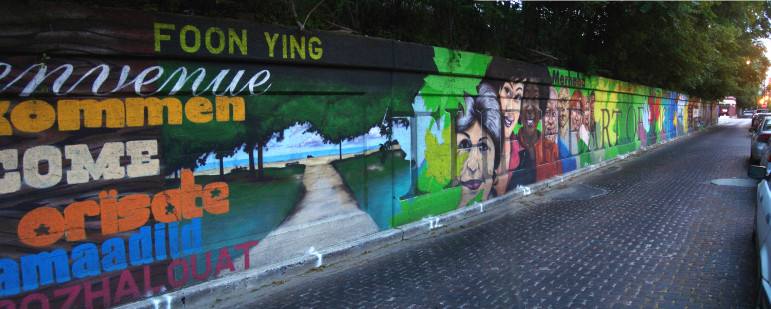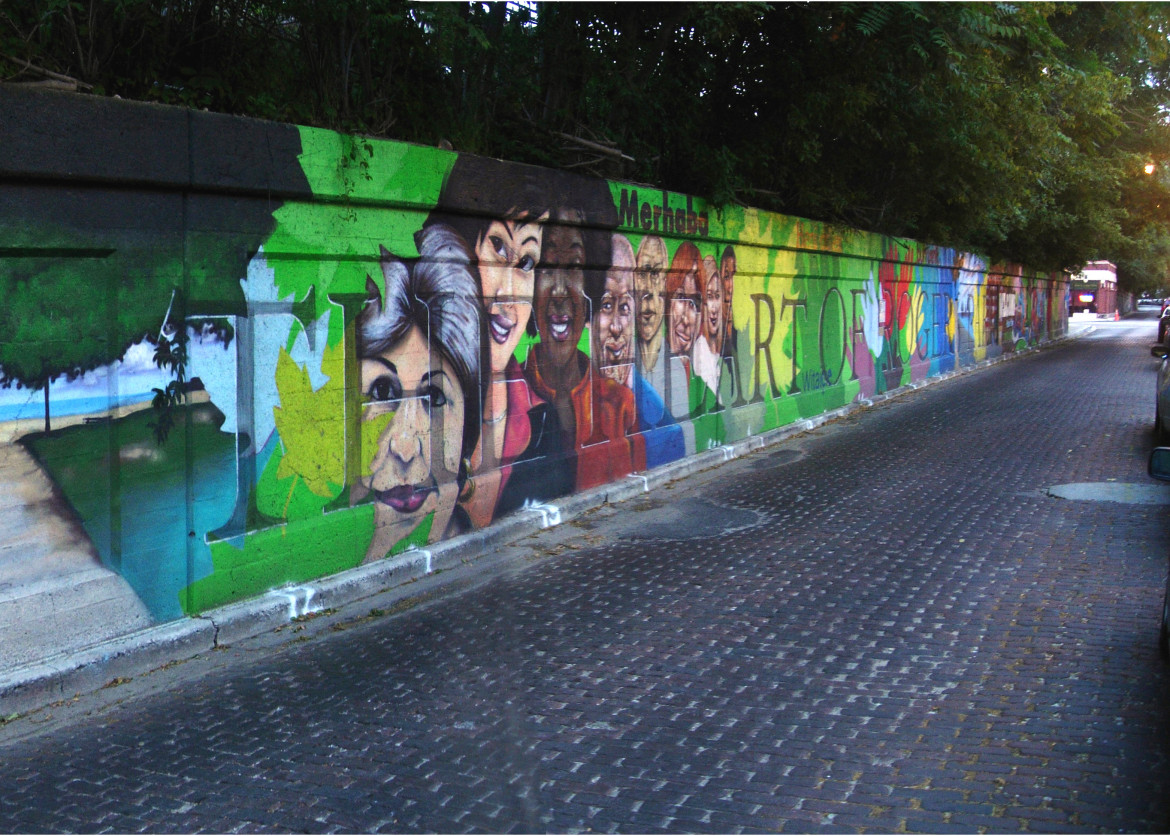
Keith Cooper / Flickr
A community mural in Rogers Park, a neighborhood on the North Side of Chicago.
From The Chicago Bureau:
CHICAGO — This is an era where people put all aspects of their lives on display through social media, and those they choose to call our “friends” on Facebook and Twitter are not the only ones who are watching. Companies and organizations monitor the online presence of their employees and potential hires. Universities prescreen their applicants and are more than willing to throw out a brilliant one if they swear in their status updates or hold beer cans in their profile pictures.
So it may surprise to hear that street gangs in the Chicago neighborhood of Rogers Park, and elsewhere, have been chronicling illegal activity on the Internet for anyone to see.
 Over the last few years in Rogers Park, a feud between two rival factions of the Gangster Disciples street gang has turned into a vicious cycle of hits and retribution. The two groups have engaged in several acts of violence against each other. In July 2013, Blake Lamb, 22, was shot.
Over the last few years in Rogers Park, a feud between two rival factions of the Gangster Disciples street gang has turned into a vicious cycle of hits and retribution. The two groups have engaged in several acts of violence against each other. In July 2013, Blake Lamb, 22, was shot.
Not long after, a member of the rival group released a music video on YouTube taunting the man’s death. In the video, the singer and several other members of his crew wave what appear to be pistols and assault rifles, aiming them at the camera.
In February 2014, a masked gunman opened fire into a group of teens standing at a McDonald's. The shooter was reportedly aiming at one gang member, and wounded him, but the lone fatality was Markeyo Carr, 17, an unaffiliated, innocent youth who had just gotten home from school. Later, suspected gang members were accused of posting photos of the memorial to the slain youth on social media, as if it was a “trophy” of their violent act.
But if the music video was shocking, what may be even more so is the fact that these gangsters are active on other forms of social media, and are marketing themselves as gangsters — including to youth to boast about their lifestyle.
Several members of both groups have Facebook accounts, and some even have Twitter and Instagram. They post pictures of themselves holding guns, smoking what looks like marijuana and wearing insignia of their affiliations. Several people, including community organizer Chris Patterson, author of the book "21: The Epitome of Perseverance" and director of the Ceasefire outreach program in Chicago, believe this is a common problem among affiliated youths.
“It’s all they do,” said Patterson, who himself had a history in crime and has since devoted his life to violence prevention and community work. “People fill their entire pages [by] antagonizing each other, through gang slogans or personal jabs.”
Although many of these individuals have protected accounts and don’t use their real names on Facebook and YouTube, some of what they post is visible to anyone who chooses to look. This includes the police, and law enforcement agencies are not standing pat.
Since the video was posted on YouTube, two of the people in it have been arrested. The first was Durane Oden, 22, who was discovered with 38 grams of crack cocaine and a weapon when police searched his home upon suspicion that stemmed from the video. Oden was on probation for a prior charge.
Then Darvis Hurt, 21, was arrested for violating parole. The Chicago Police Department was able to track Hurt down after identifying him in the video, and they nabbed him on weapons charges.
Authorities are actively tracking social media by hiring Internet-monitoring contractors to follow the activity of suspicious individuals. The customer base for these agencies has multiplied since Facebook and Twitter have exploded, and now, anything that people post online can be used against them.
So if law enforcement agencies are actively monitoring social media, why do these gang members feel the need to promote themselves in that manner on YouTube and Facebook if it could mean getting thrown in jail? One big reason is intimidation. These individuals like to take photos of themselves with weapons or gang signs in order to intimidate others.
“They’re bragging, they’re basically boasting,” said James Alan Fox, a criminologist at Northeastern University in Boston. “It helps them strike fear into their rivals. But it can also be used against them. It’s a double-edged sword.”
“They want to be looked at as gangsters,” Patterson said. “They want to be looked at as hard. They want to be looked at as being proficient enough to be able to buy pistols. They’re not necessarily thinking about the ramifications of their actions.”
Another theory says that gangsters take pictures and record videos of violent acts as a way of reliving the events. These individuals engage in their lifestyle because they get a rush from fighting or stealing, and video or photographic evidence is a way for them to get that rush again.
“It’s a way to relive a crime,” said Arthur Lurigio, a criminologist at Loyola University Chicago. “When a criminal takes a video of them performing a beating, for example, watching it again later is almost a way for them to vicariously celebrate the act. They feel the same type of adrenaline rush as they did when they did the beating.”
Regardless of why these gang members are marketing themselves on social media, they are a real threat to Rogers Park, and they make the gang landscape a whole lot more visible.
There were 10 recorded homicides in Rogers Park last year, and gang activity continues to course through the Internet, to the point where Rogers Park Police Cmdr. Thomas Waldera called the online interactions “technological kerosene.” Just as the Internet has changed the world, it has changed the gang landscape, as well.
Maya Voelk and Angelene Sun contributed reporting this story.
This story was produced by the Chicago Bureau.
